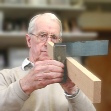

The underside of the cap-iron needs to be a perfect fit with the backface of the plane iron, otherwise the shaving will insinuate itself in any gap and soon clog the plane.
If on its way up the face of the blade its leading edge hits even a narrow flat surface, a shaving will not be deflected up the curved face of the cap-iron. It will tend to be arrested and crumple into a zig-zag that soon blocks the mouth. This means that the leading edge of the cap-iron needs to be quite sharp
On a Stanley/Record a tangent to the curve at the very tip seems to be at 45 degrees to the face of the blade, thus making the tangent vertical when the iron assembly is on the frog.
There is a tendency with some timbers for a gunge to build up in the space between the edge and the front lip of the cap-iron.
If you polish the last few millimetres of the cap iron upper face, thin and lacy shavings might be less likely to catch.
As far as thin shavings (eg less than 3thou) are concerned, I have come to doubt what some people say about the cap-iron breaking the shaving and thus preventing the leverage that plays a part in inducing tearout. In my view, a thin shaving does not have enough strength to act as a beam (as is usually stated).
Some photos that show close ups of broken shavings seem to refer to those in the region of 30 thou thick - a different matter entirely. I reckon that planing a 30thou shaving on hardwoods would take some doing.
When aiming for a tear-free finish with difficult grain, A narrow shaving aperture is more important than cap-iron position. For example when finish-planing some Australian Eucalyptus with a fiddle back figure, I put a 2.5mm thick iron into my Stanley smoother instead of the standard 2.2mm blade that usually gives an aperture in the region of 20thou. This reduced the shaving aperture to about 3 thou in the middle of the blade. The cap-iron was set at about its customary 0.5mm or less (20thou). The first shaving clogged, but the aperture passed a 1.5 thou shaving when the cap-iron was adjusted backwards (again by eye) to what subsequently proved to be about 56 thou (1.4mm), ie about 1/16".